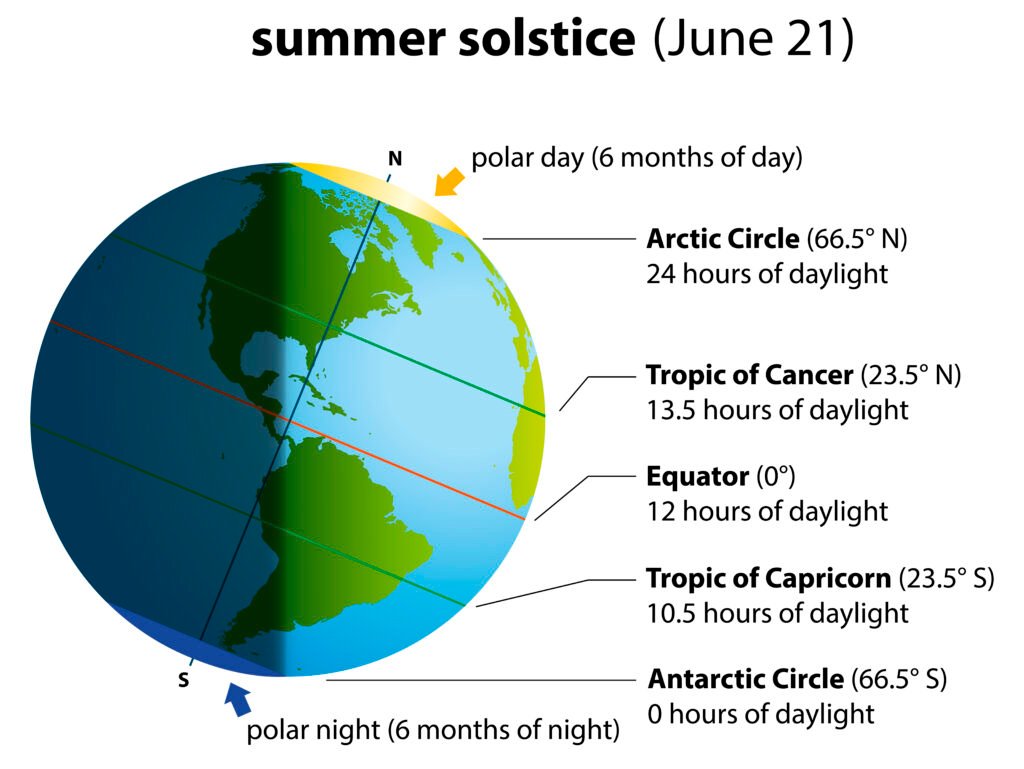Science Is Happening—Right Now!
Did you know June brings the longest day of the year? The Summer Solstice is a perfect moment to help your child see science in action—right in your own backyard!
What Is the Summer Solstice?
The Summer Solstice usually falls on June 20th or 21st in the Northern Hemisphere. It’s the day when we have the most daylight hours all year! This happens because the Earth is tilted on its axis, and during the solstice, the North Pole is tilted closest to the Sun. That means the Sun takes its longest, highest path across our sky.
Why does this matter?
The Summer Solstice marks the beginning of summer. It’s a great chance to talk about how Earth’s movement and tilt shape our seasons, our weather, and even our daily routines.
What About Daylight Saving Time?
Daylight Saving Time (DST) is when we set our clocks forward in spring and back in fall to “save” daylight. While DST changes the time on our clocks, it doesn’t change the actual amount of daylight we get—the Summer Solstice will always be the day with the most sunlight, no matter what the clock says!
Key Vocabulary
- Solstice (Latin root: sol = sun, sistere = to stand still): The point when the sun appears to reach its highest or lowest point in the sky.
- Axis (Greek root: axōn = axle): An imaginary line Earth spins around.
- Orbit (Latin root: orbita = track, course): The path Earth takes around the Sun.
- Hemisphere (Greek root: hemi = half, sphaira = sphere): Half of a sphere, like the Northern or Southern Hemisphere.
- Tilt: The angle at which Earth is tipped compared to its orbit.
- Daylight Saving Time: The practice of changing clocks to extend evening daylight.
Sample Questions & Answers (NGSS-Aligned, by Grade Level)
Kindergarten & Grade 1
- Q: What do you notice about the Sun on the longest day of the year?
- A: The Sun is up for a long time! It rises early and sets late.
Grade 2
- Q: Why do we have more daylight in June than in December?
- A: Because the Earth is tilted, and in June, our part of Earth is tilted toward the Sun.
Grade 3
- Q: How does the tilt of Earth’s axis cause the seasons?
- A: When our hemisphere is tilted toward the Sun, we get more direct sunlight and longer days (summer). When it’s tilted away, we get less sunlight and shorter days (winter).
Grade 4
- Q: How does the orbit of Earth around the Sun combine with Earth’s tilt to create the solstice?
- A: As Earth orbits the Sun, the tilt stays the same, so at one point (the solstice), the North Pole is closest to the Sun, giving us the longest day.
Grade 5
- Q: How does Daylight Saving Time affect our experience of the solstice?
- A: Daylight Saving Time changes the clock but not the amount of sunlight. The solstice is still the longest day, even if the clock says a different time for sunrise or sunset.
Activities for All Nine Intelligences
1. Linguistic:
Write a “Sun Diary”—track sunrise and sunset times for a week and describe how your day changes.
2. Logical-Mathematical:
Graph the number of daylight hours each day for a week before and after the solstice.
3. Spatial:
Draw or model how Earth tilts toward the Sun during the solstice.
4. Bodily-Kinesthetic:
Use your body to “act out” Earth’s tilt and orbit, or create a shadow stick outdoors and measure shadow lengths throughout the day.
5. Musical:
Make up a “Longest Day” song or rhythm using instruments or household items.
6. Interpersonal:
Work with a sibling or friend to observe and compare shadow lengths at different times of day.
7. Intrapersonal:
Reflect or journal about how you feel on the longest day—do you have more energy? How do you use the extra daylight?
8. Naturalistic:
Go outside and observe how plants and animals behave on the longest day. Do you notice any changes?
9. Existential:
Discuss big questions: Why do we have seasons? How do people in different cultures celebrate the solstice?
Digging Deeper: What Is Depth of Knowledge (DOK)?
Depth of Knowledge (DOK) is just a way to describe how deeply students are thinking and learning.
- Level 1: Recall facts (What is the solstice?)
- Level 2: Use skills and concepts (Graph daylight hours.)
- Level 3: Think strategically (Explain how Earth’s tilt and orbit work together to create seasons.)
- Level 4: Extend and apply knowledge (Compare how different cultures mark the solstice, or design an experiment to measure sunlight.)
Sample DOK Activity:
- “Design a simple experiment to measure how long your shadow is at different times of the day. What do you notice? Why do you think your shadow changes?”
Want more in-depth, multi-level activities like this? My books include DOK questions and hands-on STEAM projects for every learning style! You can explore more on my Amazon Author’s Page.
Keep Exploring!
Science is happening all around you—especially on the longest day of the year. Try these activities, ask questions together, and see what you discover. For more ideas and deeper explorations, check out my book series, where every lesson is designed to make science real, integrated, and fun for your whole family.

